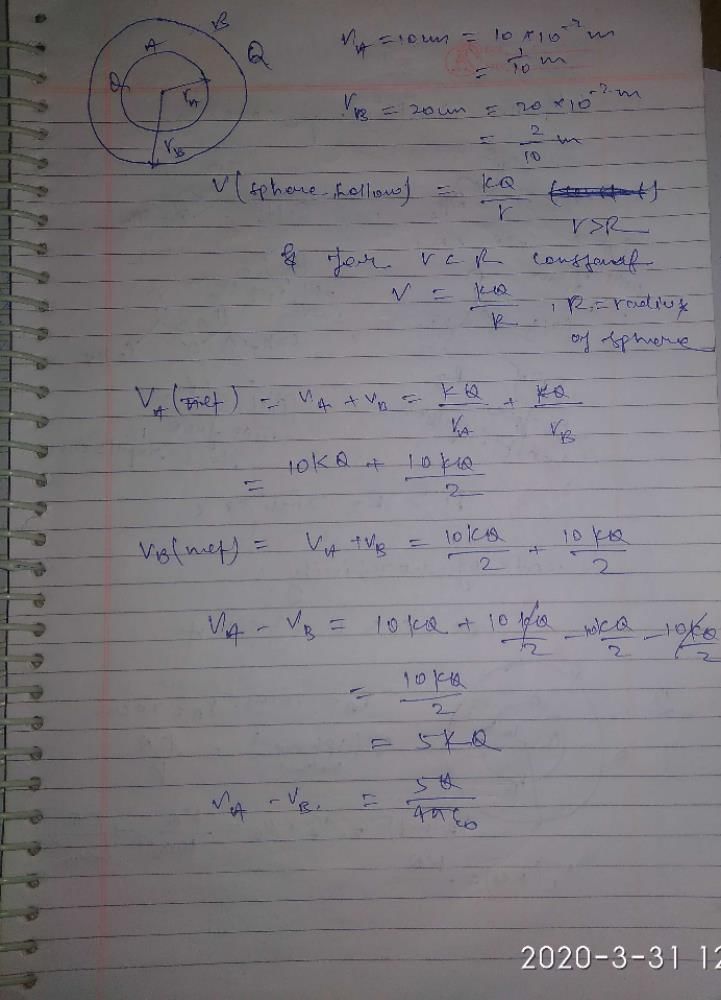JEE Exam > JEE Questions > Two concentric uniformly charged spheres of r...
Start Learning for Free
Two concentric uniformly charged spheres of radius 10 CM and 20cm potential difference between the sphere?
Most Upvoted Answer
Two concentric uniformly charged spheres of radius 10 CM and 20cm pote...
Calculation of Potential Difference between Two Concentric Uniformly Charged Spheres
Given Information
- Radius of the inner sphere = 10 cm
- Radius of the outer sphere = 20 cm
Assumptions
- The charge on both spheres is uniformly distributed.
- The charge on both spheres is spherically symmetric.
Calculation of Potential Difference
The potential difference between two concentric uniformly charged spheres can be calculated using the following formula:
V = k( Q1 / r1 - Q2 / r2 )
Where,
- V = Potential difference between the two spheres
- k = Coulomb's constant = 9 x 10^9 Nm^2/C^2
- Q1 = Charge on the inner sphere
- r1 = Radius of the inner sphere
- Q2 = Charge on the outer sphere
- r2 = Radius of the outer sphere
Since the spheres are uniformly charged, we can calculate the charge on each sphere as:
Q = 4πεr^2σ
Where,
- Q = Charge on the sphere
- ε = Permittivity of free space = 8.85 x 10^-12 C^2/Nm^2
- r = Radius of the sphere
- σ = Surface charge density
Since the charge is uniformly distributed, we can calculate the surface charge density as:
σ = Q / (4πr^2)
Using the above formulas, we can calculate the charge on each sphere:
- Charge on the inner sphere (Q1) = 4πεr1^2σ
- Charge on the outer sphere (Q2) = 4πεr2^2σ
Substituting the above values in the formula for potential difference, we get:
V = k( Q1 / r1 - Q2 / r2 )
V = 9 x 10^9 ( (4πεr1^2σ) / r1 - (4πεr2^2σ) / r2 )
V = 9 x 10^9 ( 4πεσ / r1 - 4πεσ / r2 ) (r1^2r2^2 / r1r2)
V = 36πεσ (r2^2 - r1^2) / r1r2
Substituting the values of ε, σ, r1, and r2, we get:
V = 36π(8.85 x 10^-12)( (1 / 0.1) - (1 / 0.2) ) / 0.1 x 0.2
V =
Community Answer
Two concentric uniformly charged spheres of radius 10 CM and 20cm pote...

Attention JEE Students!
To make sure you are not studying endlessly, EduRev has designed JEE study material, with Structured Courses, Videos, & Test Series. Plus get personalized analysis, doubt solving and improvement plans to achieve a great score in JEE.

|
Explore Courses for JEE exam
|

|
Similar JEE Doubts
Two concentric uniformly charged spheres of radius 10 CM and 20cm potential difference between the sphere?
Question Description
Two concentric uniformly charged spheres of radius 10 CM and 20cm potential difference between the sphere? for JEE 2024 is part of JEE preparation. The Question and answers have been prepared according to the JEE exam syllabus. Information about Two concentric uniformly charged spheres of radius 10 CM and 20cm potential difference between the sphere? covers all topics & solutions for JEE 2024 Exam. Find important definitions, questions, meanings, examples, exercises and tests below for Two concentric uniformly charged spheres of radius 10 CM and 20cm potential difference between the sphere?.
Two concentric uniformly charged spheres of radius 10 CM and 20cm potential difference between the sphere? for JEE 2024 is part of JEE preparation. The Question and answers have been prepared according to the JEE exam syllabus. Information about Two concentric uniformly charged spheres of radius 10 CM and 20cm potential difference between the sphere? covers all topics & solutions for JEE 2024 Exam. Find important definitions, questions, meanings, examples, exercises and tests below for Two concentric uniformly charged spheres of radius 10 CM and 20cm potential difference between the sphere?.
Solutions for Two concentric uniformly charged spheres of radius 10 CM and 20cm potential difference between the sphere? in English & in Hindi are available as part of our courses for JEE.
Download more important topics, notes, lectures and mock test series for JEE Exam by signing up for free.
Here you can find the meaning of Two concentric uniformly charged spheres of radius 10 CM and 20cm potential difference between the sphere? defined & explained in the simplest way possible. Besides giving the explanation of
Two concentric uniformly charged spheres of radius 10 CM and 20cm potential difference between the sphere?, a detailed solution for Two concentric uniformly charged spheres of radius 10 CM and 20cm potential difference between the sphere? has been provided alongside types of Two concentric uniformly charged spheres of radius 10 CM and 20cm potential difference between the sphere? theory, EduRev gives you an
ample number of questions to practice Two concentric uniformly charged spheres of radius 10 CM and 20cm potential difference between the sphere? tests, examples and also practice JEE tests.

|
Explore Courses for JEE exam
|

|
Suggested Free Tests
Signup for Free!
Signup to see your scores go up within 7 days! Learn & Practice with 1000+ FREE Notes, Videos & Tests.

























